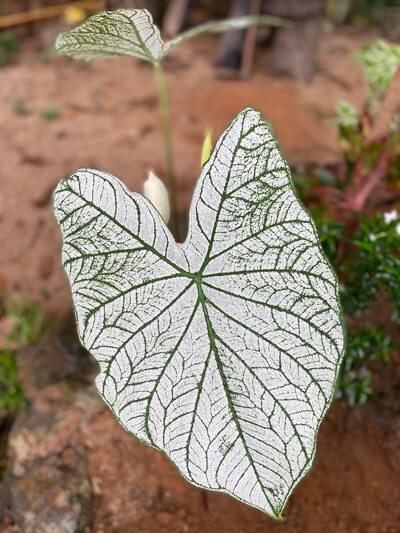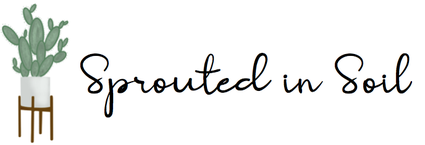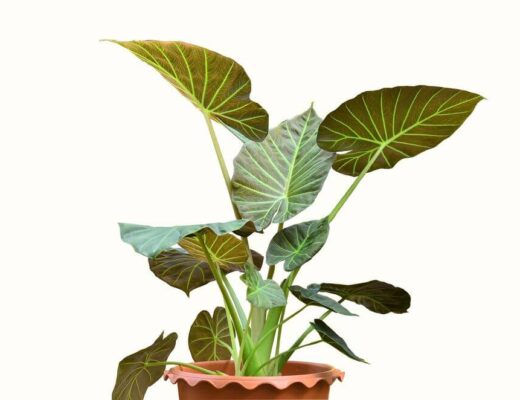The Caladium White Christmas is just one one of thousands of striking Caladium cultivars. Caladium White Christmas is a stunning cultivar that boasts luscious stark white leaves, veined with deep green lines creating an impressive contrast. These large leaves are heart shaped and are the star of the show!
Caladium White Christmas care is straight forward, making it a great plant to display indoors or establish outdoors in gardens. Learn more about how to provide outdoor care and indoor care for the eye-catching White Christmas Caladium!
Table of contents
Quick Facts

- Common Name: White Christmas Caladium, Heart of Jesus, Angel Wings, Elephant’s Ears
- Scientific Name: Caladium bicolor ‘White Christmas’
- Mature Size: 16”-24” tall and wide
- Sunlight: partial shade, indirect light indoors
- Water: when surface soil feels dry
- Soil: well draining soil, slightly acidic soil
- Temperature: 70°F-85°F
- Hardiness Zone: 8-10
- Propagation: tubers, offsets
Caladiums are a genus of tuberous, flowering perennials that make attractive houseplants. This is due to their broad, heart-shaped leaves, which are often splotched with striking patches of color. In warmer climates, they also make excellent ornamental additions to an outdoor garden.
Different varieties are often named after their unique physical attributes. The Caladium White Christmas earns its name from its white leaves with contrasting green veins. This unusual coloring makes the leaves appear frosted, evoking memories of the Christmas season. However, you can enjoy your Caladium White Christmas’ foliage all year long by simply providing a few basic needs.
Growth Pattern and Habits
Like all Caladium cultivars, the Caladium White Christmas plants originated from the jungles of Central and South America. Because of its tropical origins, it doesn’t tolerate frost or temperatures lower than 60°F. Therefore, it grows best when it’s raised indoors or inside of a greenhouse.
With a little extra planning and work, however, this plant can still thrive outdoors in temperate regions with short, mild winters. The easiest way is to plant your White Christmas Caladium in a pot so it can be brought indoors during the colder months. If you decide to plant it in the ground, harvest the bulbs before the first frost. The plant will eventually die, but you can store your bulbs over the winter and plant them in the spring, which will hopefully yield a new generation of White Christmas Caladiums.

In the summer, the White Christmas Caladium grows white, calla-like flowers under the shade of its own leaves. However, the flowers are often hard to see and serve little ornamental purpose compared to the leaves, which are much more noticeable. To keep your plant looking its best, regularly prune dying or odd-looking leaves, which allows the plant to grow more flower buds and larger, more impressive leaves.
Sunlight
Does the White Christmas Caladium like full sun? This is a common question! The White Christmas Caladium prefers full shade. Indoors, it should be placed near a north or east-facing window, both of which provide access to indirect sunlight for most hours of the day. Outdoors, it grows best on a covered balcony or under the shade of a tree.
While the White Christmas caladium is sun tolerant, too much direct sunlight will scorch the plant’s leaves, causing them to develop dry, brown patches. However, the plant will lose its color if it doesn’t receive enough sun. To strike the right balance, aim to position your White Caladium plant in a well-lit area, but be prepared to move it or provide additional shade if it shows signs of scorching.
Water
Watering frequency for the Caladium White Christmas depends on its environment. In general, the plant should be watered enough to keep its soil slightly damp, but not soggy. To figure out your plant’s watering schedule, add an inch of water when the surface of the soil appears dry. Typically, this means you will water your plant once every two or three days during the cooler months and up to once a day during the summer.

Droopy, wilted leaves and poor growth are sure signs of underwatering. Meanwhile, overwatering will cause leaves to fall off. You are more likely to underwater your White Christmas Caladium. For this reason, it’s very important to figure out and stick to a watering schedule.
Soil
The Caladium White Christmas is hardy in most soil types but grows best in well-draining soil. Most people do just fine with any available potting mix. If you choose to raise your plant in a pot, be sure to select a container with drainage holes.
To provide the best environment possible, you may consider testing your soil’s pH level. The White Christmas Caladium prefers a pH level of 5.5-6 out of a possible 14, putting it in a slightly acidic territory. To lower your soil’s pH level naturally, you can add a small amount of compost. You can also try mixing in some natural, moisture-retaining materials, like sawdust, peat moss, or mulch, to ensure the soil stays evenly saturated while lowering its pH level at the same time.
Temperature and Humidity
This tropical plant prefers moderately warm temperatures. The ideal range is 70°-75°F, but it can survive higher temperatures if it has access to enough water. On the other hand, any temperatures below 60°F can result in root shock and leaf frost, eventually killing the plant. Mulch can be helpful for warming the soil and delaying frost if you choose to raise your plant outdoors.

The ideal relative humidity for the Caladium White Christmas is 50-60%, which is similar to its native environment. It grows very well planted outdoors in warm, humid climates, such as along the gulf coast of the Southern U.S. If your local climate is relatively dry, you can simply house your plant indoors near a humidifier or lightly mist your plant every other day.
Fertilization
The Caladium White Christmas doesn’t require as much nutrients when compared to other similar houseplants, but occasional feedings will ensure the soil stays fertile enough to continue fueling plant growth. You can use any high-quality fertilizer with an equal balance of nitrogen, phosphorus, and potassium.
Just make sure to dilute it with water to about 50% strength, and wait at least one month between feedings. Look out for yellowing leaves, which is a sign of too much fertilizer.
Propagation
Unlike many other plants Caladiums cannot be propagated by leaf cuttings. The White Christmas Caladium spreads naturally by sending out tubers which then grow upwards into new plants.

You can propagate your White Christmas Caladium this same way, creating new plants by cutting or separating its tubers. You can also wait for the propagation to happen naturally and separate a new baby offset from the mature plant. Let’s discuss the two ways to propagate a Caladium White Christmas
Propagation from Tubers
Like many tuberous plants, the White Christmas Caladium grows from hard, kernel-like bulbs, which are produced near the plant’s roots. When propagating this plant, the very first step is to harvest and separate its tubers.

If your plant is potted, gently remove it from its container and use a sterilized knife or scissors to separate the bulbs from the host plant. If your plant is planted directly in the ground, gently dig the White Christmas Caladium tubers or bulbs from the ground.
Next, separate or cut the tubers into pieces ensuring that each new section has at least one knob. This is a protrusion in the tuber that may even have a small growth emerging from it. This is the place from which new plants grow.
Once you have several bulbs harvested, discard any that appear damaged or rotten. Then, store them in a cool, dry place and allow them to cure for one week. The curing process will help each bulb develop a hard, tough skin, called a “callous,” which will increase the chances of successful propagation. For best results, store your bulbs in a container that still allows air flow, such as a cardboard box, burlap sack, or newspapers.

After your bulbs have cured, prepare them for planting by placing them knob side up. Then, plant each bulb in soil at a depth of about two inches. Under ideal conditions, your White Caladium plant bulb should start producing foliage in one to two weeks.
Propagation from Offsets
With proper care, your White Christmas Caladium may start producing new shoots alongside the mother plant. When this happens, you can propagate the plant by carefully digging out the fresh shoots and potting them in a separate container.
Be sure to dig up the entire plant bulb, keeping as many roots intact as you can. Uproot the bulb with a gentle, twisting motion, or use a sterilized knife if it’s too difficult to remove the bulb by hand.
Common Issues
Bacterial Blight
Most species of the Caladium genus, including the White Christmas Caladium, are susceptible to infection by the Xanthomonas axonopodis strain of bacteria. This infection begins by causing small, brown lesions to develop on the underside of the plant’s leaves. From there, the infection spreads to the rest of the plant through its vascular system.
To prevent your White Christmas Caladium’s untimely demise from bacterial blight, prune off leaves that show early signs of infection before it has a chance to spread. Raise your plant under ideal conditions to keep it healthy and able to fight off infections. Finally, always use sanitized shears whenever you prune your plant so you’re less likely to introduce foreign bacteria directly into your plant’s veins.
Snails and Slugs
Snails and slugs enjoy warm, humid environments where food sources are abundant, and they will love feasting on the leaves of your White Christmas Caladium. If you are growing your White Christmas Caladium outdoors, these gastropods can cause a host of issues.

You can tell if you’ve been infested by snails and slugs when your plants have unexplained holes in their leaves accompanied by silvery trails of dried slime. To address these pests, you can simply pick them off by hand and drop them in a bucket of soapy water to humanely kill them. Because they’re nocturnal, the best time to spot them is at night or very early in the morning.
The best way to discourage snails and slugs from visiting your garden is to eliminate daytime hiding places, such as large pieces of wood, weeds, and other debris. You can also try planting aromatic herbs, such as chives and garlic, as a natural pest repellent. To make the garden even less hospitable to these humidity-loving invertebrates, try switching to a drip irrigation system for watering your outdoor plants.
Sunburn
This plant is highly sensitive to sunburn, so it’s best to avoid placing it in direct sunlight. You can tell if your plant is sunburnt if it develops dry, brittle patches on its leaves. Always place your Caladium White Christmas in full shade, and use a curtain to filter light if your plant is near a sunny window.
Toxicity
All parts of the White Christmas Caladium are toxic to people and pets, including its bulbs, stems, and leaves. This is primarily due to the presence of calcium oxalate crystals and the protein asparagine in its sap. Calcium oxalate crystals are tiny, insoluble, and riddled with sharp edges that can cause microscopic tears in the mouth and throat when ingested. Corneal abrasions can also occur if you accidentally touch your eyes after getting sap on your fingers.

Meanwhile, asparagine can trigger inflammation of the mucous membranes. Combined with calcium oxalate, this can cause extreme burning in the mouth. Other symptoms of White Christmas Caladium poisoning include nausea, excess salivation, hoarseness, swelling, and diarrhea.
If you catch a family member or pet ingesting part of your White Caladium plant plant, remove all traces of the plant from their mouth and encourage them to drink something cool, such as water or milk. This will flush their mouth clean and hopefully soothe any irritation that has occurred. To prevent irritation from the sap getting on your skin or eyes, always remember to put on your gloves before you prune your plant.
In most cases, the symptoms of Caladium poisoning are relatively mild, and most people can manage them with some rest and self-care. Contact poison control or emergency services if symptoms worsen or if you develop breathing difficulties. Be prepared to provide the type of plant that was eaten, the amount, and how much time has passed since it was ingested.
Wrapping Up
With its wide beautiful leaves, the Caladium White Christmas plant is always a hit. This plant is a great way to lighten up a dark room or to add contrast to a garden. It can be grown as a houseplant or outdoors! The Caladium White Christmas does produce small flowers but the leaves are its best feature. I hope you now feel confident in pulling off perfect Caladium White Christmas indoor care!




